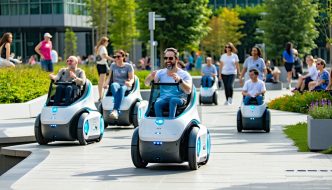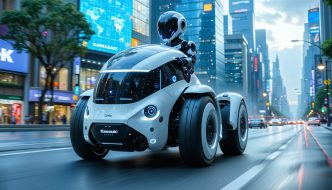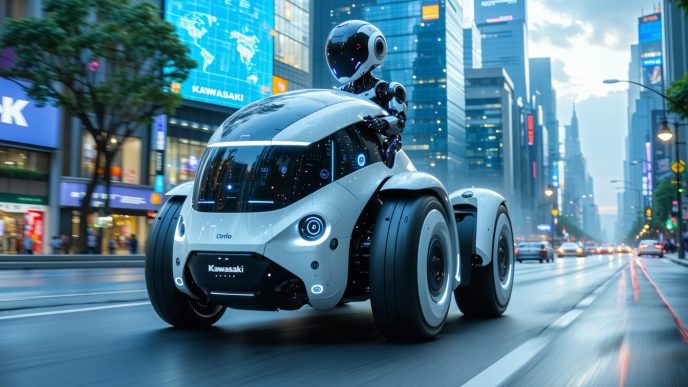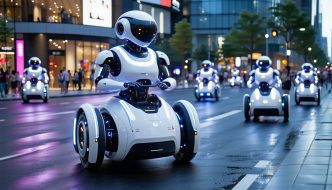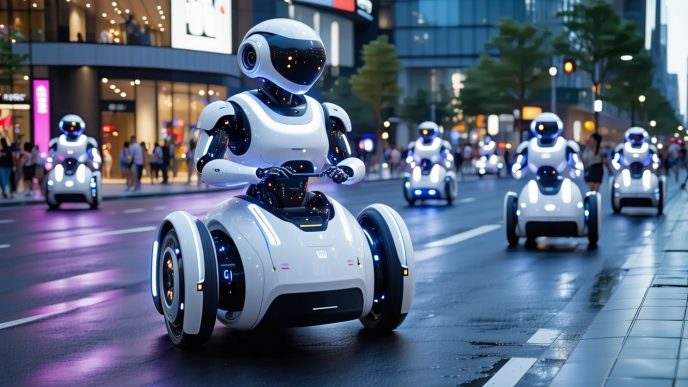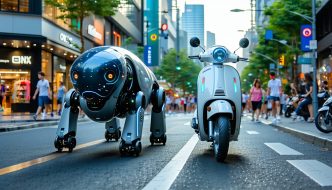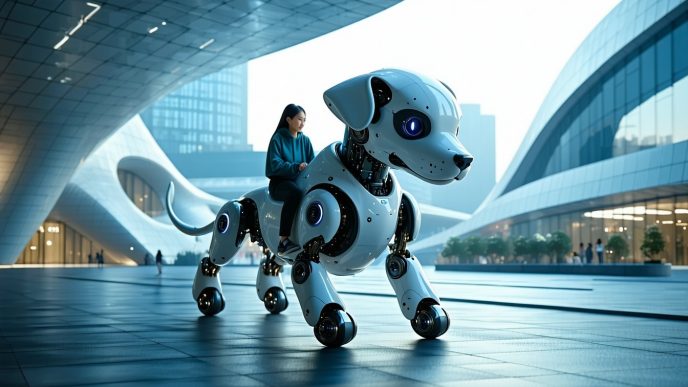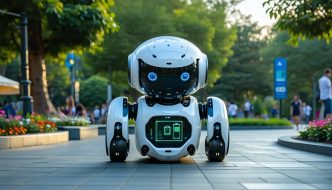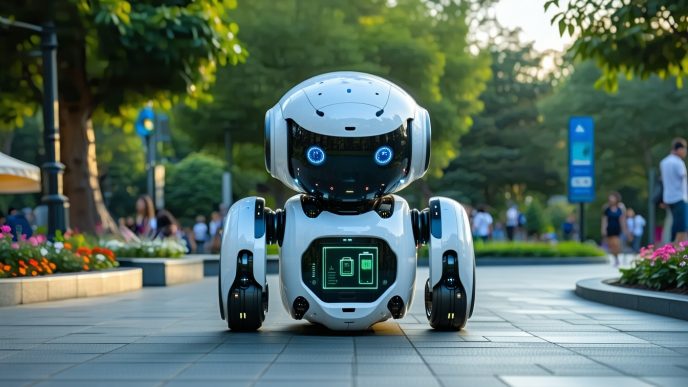The Evolution of Rideable Robots
Introduction to Rideable Robots
Rideable robots represent a significant advancement in mobility technology, combining robotics with practical transportation solutions. These machines are designed to accommodate various mobility needs, particularly aiding those with disabilities. By providing an innovative mode of transportation, rideable robots aim to enhance freedom and independence for users who may face mobility challenges. This includes tailored designs and features focused on comfort and usability, ensuring that users can navigate diverse environments with ease.
Recent years have seen a surge in the development and adoption of rideable robots. Manufacturers have focused on creating models that are accessible and user-friendly. The following table outlines some key features commonly found in various rideable robots for disabled mobility.
| Feature | Description |
|---|---|
| Adjustable Seating | Customizable height for user comfort and accessibility |
| Stability Systems | Enhances balance and safety during operation |
| User-Friendly Controls | Intuitive interfaces for easy navigation |
| Compact Design | Facilitates indoor and outdoor use |
| Smart Technology | Integration with mobile devices for tracking and navigation |
How Rideable Robots are Revolutionizing Mobility
Rideable robots are changing the landscape of mobility for disabled individuals by breaking down barriers that limit access to essential resources. For instance, these robots can navigate public spaces, aiding users in shopping, commuting, and socializing. They empower individuals to regain a sense of normalcy by providing a new level of autonomy.
One significant development is the transition from traditional mobility aids like wheelchairs to more advanced rideable options such as kawasaki corleo robot and the xiaomi cyberdog 2 rideable concept. These advanced robots offer features tailored specifically to enhance mobility while ensuring a user-friendly experience.
Rideable robots are also increasingly being compared to conventional mobility devices, leading to discussions about the benefits and drawbacks of each option. For example, a comparison between rideable quadrupeds vs scooters demonstrates how different approaches can meet various needs depending on terrain, user preference, and functionality.
Overall, the evolution of rideable robots is not only transforming accessibility but also shaping a future where mobility solutions are diverse and inclusive. As these technologies continue to develop, they promise to redefine what independence looks like for many individuals. For insights on factors like the battery life of rideable robots, further exploration is encouraged to understand the practical implications of adopting such technologies for personal and professional use.
Accessibility and Mobility Challenges
The need for effective mobility solutions is critical for individuals with disabilities. Understanding the specific accessibility needs of this population is essential in developing appropriate technologies, such as rideable robots.
Understanding Accessibility Needs
Accessibility needs encompass a variety of requirements based on individual circumstances. These can range from difficulty in walking or standing to the inability to navigate uneven surfaces. The key aspects of accessibility needs include:
| Accessibility Need | Description |
|---|---|
| Physical Mobility | Requires assistance for moving between locations, be it indoors or outdoors. |
| Navigation | Needs support in locating safe pathways, especially in complex environments. |
| Independence | A strong desire for self-sufficiency in daily activities and mobility. |
Professionals and tech developers must consider these needs when designing solutions to enhance mobility.
Current Solutions and Limitations
Current options for aiding mobility include wheelchairs, scooters, and walking aides. While these solutions provide varying degrees of support, they also come with limitations.
| Current Solution | Limitations |
|---|---|
| Wheelchairs | Limited movement range; dependence on caregivers for pushing. |
| Scooters | Difficulty navigating tight spaces and curbs; weight restrictions may apply. |
| Walking Aides | May not provide sufficient support for those with significant mobility challenges. |
None of the existing tools address the problem perfectly, which opens the door for innovative alternatives like rideable robots for disabled mobility. As technology progresses, evaluating how concepts such as the Kawasaki Corleo robot or the Xiaomi Cyberdog 2 rideable concept can fill gaps in mobility solutions is essential.
As we continue to explore how adaptive technologies can reshape mobility, there is significant potential to enhance independence and improve the overall quality of life for individuals with disabilities.
Rideable Robots for Enhanced Mobility
Features of Rideable Robots
Rideable robots designed for enhanced mobility come equipped with a diverse range of features that cater to the needs of users. These features significantly improve the experience for individuals with disabilities. Some of the key attributes include:
| Feature | Description |
|---|---|
| Adjustable Seating | Many rideable robots offer customizable seating arrangements to accommodate various body types and preferences. This increases comfort during use. |
| Smart Navigation | Integrated navigation systems help users to traverse complex environments safely and efficiently. These systems may include obstacle detection sensors and GPS. |
| User-friendly Controls | Simple and intuitive control interfaces allow users of different skill levels to operate the robots easily. Some may use joystick controls, while others might offer touchscreens or voice commands. |
| Compact Design | A foldable or compact design ensures that rideable robots can be stored or transported with minimal effort, making them practical for daily use. |
| Battery Efficiency | Advanced battery technology enhances the range and efficiency of these robots, allowing users to travel longer distances without frequent recharging. For detailed insights into battery life, refer to the article on battery life of rideable robots. |
Benefits of Rideable Robots for Disabled Mobility
The advantages of utilizing rideable robots for disabled mobility are profound. They not only address specific mobility challenges but also enhance overall quality of life. Here are notable benefits:
| Benefit | Description |
|---|---|
| Increased Independence | Rideable robots empower individuals with disabilities to navigate their surroundings without needing assistance. This autonomy fosters confidence and self-sufficiency. |
| Enhanced Accessibility | With features that accommodate user needs, these robots enhance mobility in both indoor and outdoor settings, ensuring greater access to various spaces. |
| Improved Social Interaction | By facilitating easier mobility, rideable robots promote social engagement, enabling users to participate in community events and gatherings more freely. |
| Reduced Physical Strain | For individuals with mobility impairments, rideable robots reduce the physical strain often associated with traditional mobility devices, making movement more comfortable. |
| Greater Efficiency in Mobility | The advanced technology incorporated into rideable robots often allows for faster travel compared to manual mobility aids, saving time and effort in daily activities. |
As seen, rideable robots for disabled mobility are transforming how individuals navigate their environments. The combination of innovative features and meaningful benefits underscores their potential to redefine accessibility and mobility. For a broader perspective on the applications of these robots, consider exploring the section on rideable quadrupeds vs scooters.
Applications in Real-World Settings
Rideable robots are becoming increasingly prominent in various real-world applications, addressing mobility challenges for individuals in both commercial and residential settings. Their versatility and accessibility make them valuable tools in enhancing mobility options.
Commercial Use of Rideable Robots
In commercial environments, rideable robots serve multiple functions, including facilitating transportation and improving customer interactions. These robots can enhance operational efficiency by easing the movement of people, especially in large venues such as shopping malls, airports, and hospitals.
| Application | Purpose |
|---|---|
| Airports | Assist passengers with limited mobility in navigating terminals |
| Hospitals | Transport patients or deliver medications across facilities |
| Shopping Malls | Offer mobility support to shoppers, enhancing the customer experience |
By integrating rideable robots, businesses can not only cater to the needs of clients who may have disabilities but also improve overall workflow. For instance, hospitals that utilize rideable robots experience faster patient response times and a more streamlined service.
Residential Use of Rideable Robots
In residential settings, rideable robots can enhance daily living for individuals with mobility challenges. They allow users to navigate their homes and local communities more independently, improving overall quality of life.
| Application | Purpose |
|---|---|
| Home Navigation | Enable individuals to move around their homes with ease |
| Community Interaction | Allow users to visit local parks, shops, and events, fostering social engagement |
Through the use of rideable robots, individuals can experience a sense of autonomy. This is especially important for those who may have previously faced barriers in mobility. The robots can be particularly beneficial for activities such as grocery shopping or participating in community gatherings, thus promoting inclusion and engagement.
Both commercial and residential applications illustrate the potential that rideable robots hold in reshaping mobility landscapes for disabled individuals. To explore more about the various types of rideable robots, check out our article on rideable robots.
Technological Advancements
The landscape of rideable robots is continually evolving, driven by advancements in technology that enhance their functionality and usability. Innovations in rideable robot technology are pivotal in addressing the mobility challenges faced by individuals with disabilities.
Innovations in Rideable Robot Technology
Recent developments in rideable robots have focused on several key areas, including improved navigation systems, enhanced battery efficiency, and greater user interface design.
| Innovation Category | Description |
|---|---|
| Navigation Systems | Advanced GPS and sensor technology allow for accurate positioning and obstacle detection, ensuring safer travel for users. |
| Battery Efficiency | Innovations in battery technology are extending the operational time of rideable robots, reducing downtime and allowing for longer use between charges. For detailed insights, refer to our article on battery life of rideable robots. |
| User Interface | Touch screens and voice-activated controls are being implemented, making it easier for users to operate the robots independently. |
These advancements not only enhance the performance of rideable robots but also contribute to a more inclusive experience for users, allowing them to navigate their environments with greater ease and confidence.
Future Potential and Development
The future potential of rideable robots for disabled mobility is vast. Ongoing research and development are expected to yield breakthroughs that will further integrate artificial intelligence and machine learning into rideable robots. This will allow for adaptive learning, where robots can adjust to the preferences and walking styles of individual users.
| Future Development Focus | Expected Outcomes |
|---|---|
| AI Integration | Enhanced personalization of mobility experiences and better responsiveness to the user’s environment. |
| Customization Options | Greater availability of modular attachments and accessories for specific user needs. |
| Collaborative Robots | Development of rideable robots that can work alongside other assistive technologies, creating a comprehensive mobility solution. |
Innovations such as the Kawasaki Corleo robot and the Xiaomi Cyberdog 2 rideable concept illustrate the growing trend toward multifunctional robots that cater to diverse user requirements. As technology continues to advance, rideable robots are positioned to redefine mobility, making significant strides in accessibility for disabled individuals.
For further insights on comparative technologies, explore our discussion on rideable quadrupeds vs scooters and the potential of robot horses and animal-inspired bots.
Considerations for Implementation
When considering the adoption of rideable robots for improving mobility, several key factors must be addressed. Understanding these aspects is essential for ensuring that implementation is effective and that intended users can benefit maximally from this technology.
Factors to Consider Before Adopting Rideable Robots
The decision to implement rideable robots requires careful evaluation of various factors, including user needs, environment, and integration with existing systems. Below are some crucial considerations:
| Factor | Description |
|---|---|
| User Needs | It is important to evaluate the specific mobility requirements of potential users. This includes understanding individual capabilities, preferences, and how the robot can best support their needs. |
| Environment | The setting in which the robots will be utilized significantly impacts their design and functionality. Indoor versus outdoor use, terrain types, and potential obstacles should be taken into account. |
| Cost | Financial implications should be reviewed. This includes initial purchase costs, maintenance costs, and any additional expenses related to infrastructure changes or training users. |
| Training | Adequate training for users and caregivers is necessary to ensure safe operation. This may involve hands-on sessions or instructional resources for understanding the robot’s functions. |
| Regulatory Compliance | It is critical to ensure that the robots comply with local regulations regarding mobility devices and assistive technologies. Legal considerations can significantly impact implementation. |
Addressing Safety and Security Concerns
Safety and security are paramount in the deployment of rideable robots, especially for users with disabilities. Understanding these concerns can help mitigate risks and promote user confidence.
| Concern | Mitigation Strategy |
|---|---|
| Potential Accidents | Implementing safety features such as automatic braking, obstacle detection, and fail-safe mechanisms can greatly reduce the likelihood of accidents. |
| User Security | Measures should be taken to secure devices against theft or unauthorized use. This may include GPS tracking, user identification systems, and locking mechanisms. |
| Data Privacy | Many rideable robots collect data for improved functionality. Ensuring that user data is stored securely and used transparently is critical for building trust among users. |
| Emergency Situations | A protocol for emergencies, such as breakdowns or medical crises, should be integrated into the robot’s design, providing users with quick access to help or support. |
Considering these factors thoroughly will enhance the likelihood of successful implementation of rideable robots for disabled mobility. As the technology evolves, continuous evaluation and adaptation will be necessary to meet user needs effectively. For more information on the advantages of rideable robots in enhancing mobility, readers can explore further.
Impact on Accessibility and Inclusivity
Improving Quality of Life
Rideable robots for disabled mobility have the potential to significantly enhance the quality of life for individuals with mobility challenges. These advanced machines are engineered to assist with daily activities, enabling users to navigate environments with greater ease and independence. By incorporating features like user-friendly controls, adaptable seating, and automated navigation, rideable robots can address specific accessibility needs, thereby improving overall user experience and satisfaction.
The following table outlines the key improvements to quality of life as facilitated by rideable robots:
| Improvement Aspect | Description |
|---|---|
| Enhanced Mobility | Users can move freely within their environment, accessing spaces previously difficult to reach. |
| Reduction in Fatigue | Rideable robots minimize physical exertion, making daily tasks less taxing. |
| Increased Participation | Facilitates social interactions and community engagement, reducing feelings of isolation. |
| Customization | Personalization features allow users to tailor their experience according to their specific needs. |
The integration of rideable robots in various settings promotes inclusivity, as it allows individuals with disabilities to engage more fully in everyday life activities.
Promoting Independence and Empowerment
Rideable robots contribute to a greater sense of independence for users. By enabling individuals to manage their movement without reliance on assistance, these robots empower users to reclaim autonomy over their transportation. The design of these machines often encourages self-direction and control, fostering confidence in mobility.
Key aspects promoting independence and empowerment include:
| Empowerment Feature | Description |
|---|---|
| Self-Navigation | Users can maneuver the robots on their own, selecting routes and destinations. |
| Ease of Use | Simplified interfaces allow for quick learning and adaptability, minimizing barriers for first-time users. |
| Control Over Environment | Users can interact with their surroundings on their own terms without needing an individual to assist. |
| Support for Daily Living | Rideable robots can assist with errands and tasks, reinforcing self-sufficiency in daily routines. |
As rideable robots continue to evolve, they present innovative solutions that not only redefine mobility but also enhance users’ quality of life and independence. The advancements in technology offer more opportunities for individuals with disabilities to participate in a diverse range of activities, leading to a more inclusive society. For more insights on current applications and innovations, check out our related articles on rideable robots and kawasaki corleo robot.

